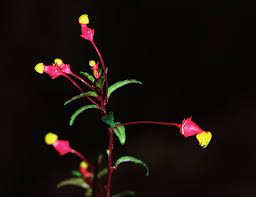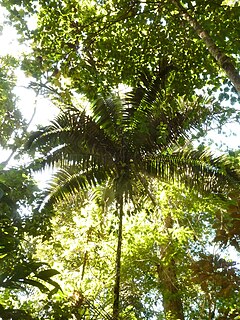
Royal Botanic Gardens, Kew is a non-departmental public body in the United Kingdom sponsored by the Department for Environment, Food and Rural Affairs. An internationally important botanical research and education institution, it employs 1,100 staff. Its board of trustees is chaired by Dame Amelia Fawcett.

Bulbophyllum is a genus of mostly epiphytic and lithophytic orchids in the family Orchidaceae. It is the largest genus in the orchid family and one of the largest genera of flowering plants with more than 2,000 species, exceeded in number only by Astragalus. These orchids are found in diverse habitats throughout most of the warmer parts of the world including Africa, southern Asia, Latin America, the West Indies, and various islands in the Indian and Pacific Oceans. Orchids in this genus have thread-like or fibrous roots that creep over the surface of trees or rocks or hang from branches. The stem is divided into a rhizome and a pseudobulb, a feature that distinguished this genus from Dendrobium. There is usually only a single leaf at the top of the pseudobulb and from one to many flowers are arranged along an unbranched flowering stem that arises from the base of the pseudobulb. Several attempts have been made to separate Bulbophyllum into smaller genera, but most have not been accepted by the World Checklist of Selected Plant Families.

Petrosaviaceae is a family of flowering plants belonging to a monotypic order, Petrosaviales. Petrosaviales are monocots, and are grouped within the lilioid monocots. Petrosaviales are a very small order of photosynthetic (Japonolirion) and rare leafless achlorophyllous, mycoheterotrophic plants (Petrosavia) found in dark montane rainforests in Japan, China, Southeast Asia and Borneo. They are characterised by having bracteate racemes, pedicellate flowers, six persistent tepals, septal nectaries, three almost distinct carpels, simultaneous microsporogenesis, monosulcate pollen, and follicular fruit.

The family Campanulaceae, of the order Asterales, contains nearly 2400 species in 84 genera of herbaceous plants, shrubs, and rarely small trees, often with milky sap. Among them are several familiar garden plants belonging to the genera Campanula (bellflower), Lobelia, and Platycodon (balloonflower). Campanula rapunculus and Codonopsis lanceolata are eaten as vegetables. Lobelia inflata, L. siphilitica and L. tupa and others have been used as medicinal plants. Campanula rapunculoides may be a troublesome weed, particularly in gardens, while Legousia spp. may occur in arable fields.

Asparagaceae, known as the asparagus family, is a family of flowering plants, placed in the order Asparagales of the monocots. The family name is based on the edible, garden asparagus, Asparagus officinalis. Those who live in the temperate climates may be surprised to learn that this family includes both common garden plants as well as common houseplants. The garden plants, include: asparagus, yucca, bluebell, and hosta. And the houseplants, include: snake plant, corn cane, spider plant and plumosus fern.

Hanguana is a genus of flowering plants with a dozen known species. It is the only genus in the family Hanguanaceae.

Lanaria is a monotypic genus of flowering plants containing a single species, Lanaria lanata, endemic to the southern coast of South Africa where it is associated with the fynbos belt. Lanaria lanata is commonly known as Cape edelweiss or lambtails. The genus is placed in the monotypic family Lanariaceae, a family only recently recognized by taxonomists. The APG IV system of 2016 does recognize this family.
The World Geographical Scheme for Recording Plant Distributions (WGSRPD) is a biogeographical system developed by the international Biodiversity Information Standards (TDWG) organization, formerly the International Working Group on Taxonomic Databases. The WGSRPD standards, like other standards for data fields in botanical databases, were developed to promote "the wider and more effective dissemination of information about the world's heritage of biological organisms for the benefit of the world at large". The system provides clear definitions and codes for recording plant distributions at four scales or levels, from "botanical continents" down to parts of large countries. Current users of the system include the International Union for Conservation of Nature (IUCN), the Germplasm Resources Information Network (GRIN), and the World Checklist of Selected Plant Families (WCSP).

Micropholis is group of trees in the family Sapotaceae, described as a genus in 1891.

Burmeistera is a genus of flowering plants in the bellflower family, Campanulaceae. There are around 130 species distributed in Central and South America. This genus represents a rapid evolutionary radiation with species having diverged within only the last 2.6 million years.
Micropholis cylindrocarpa is a species of plant in the family Sapotaceae. It is found in Brazil and Peru.

Welfia is a genus of palms found in Central America and northwestern South America. Only two species are currently recognized: Welfia regia and Welfia alfredii.

Althenia is a genus of aquatic plants of the family Potamogetonaceae. This has long been a group of two species in the Mediterranean Europe and South Africa, but in 2016 was revised to include an Australasian relative, Lepilaena.
The World Checklist of Selected Plant Families is an "international collaborative programme that provides the latest peer reviewed and published opinions on the accepted scientific names and synonyms of selected plant families." Maintained by the Royal Botanic Gardens, Kew, it is available online, allowing searches for the names of families, genera and species, as well as the ability to create checklists.
Meiogyne cylindrocarpa, also known as fingersop, is a small tree in the Annonaceae family. It is native to Borneo, Java, the Marianas, New Guinea, Northern Territory, Philippines, Queensland, Vanuatu, and Western Australia. In the Chamorro language it is known as "paipai".
Althenia cylindrocarpa is a species of aquatic plant in the family Potamogetonaceae. It is found in fresh to brackish waters in Australia. This species has been transferred from Lepilaena.

Eucalyptus cylindrocarpa, commonly known as the woodline mallee, is a species of mallee that is endemic to Western Australia. It has mostly smooth bark, sometimes with loose fibrous or flaky bark near the base of the trunk, linear to lance-shaped or curved adult leaves, flower buds in groups of seven, nine or eleven and cylindrical to barrel-shaped fruit.
Goodenia cylindrocarpa is a species of flowering plant in the family Goodeniaceae and is endemic to northern Australia. It is an erect annual, herb with spatula-shaped, or lance-shaped to egg-shaped leaves at the base of the plant, and panicles of small yellow flowers.
Sepikea is a genus of flowering plants belonging to the family Gesneriaceae.











